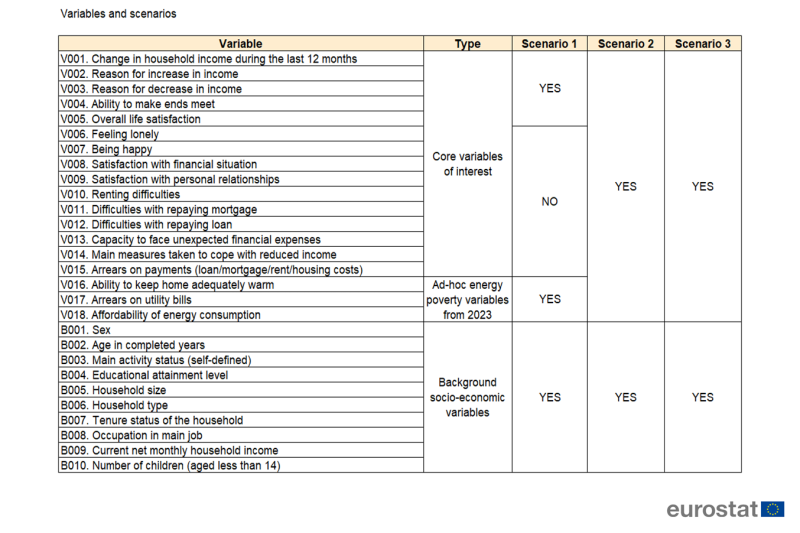Quarterly data collection on living conditions - methodology
This article describes the methodology used to produce the quarterly data collection on living conditions (QLC). It gives an overview of the data collection process and provides detailed information on the countries participating and the variables collected.
Full article
Policy data needs for quarterly data on living conditions
The COVID-19 pandemic hit Europe at the beginning of 2020, triggering an unprecedented socio-economic crisis. This situation highlighted the need for timely, intra-annual data that could help policymakers analyse the situation and take appropriate measures. In response to this, Eurostat and the statistical authorities in the Member States developed the ‘European Statistical Recovery Dashboard’. The dashboard contains monthly and quarterly indicators covering various statistical areas. The dashboard has been used to monitor the economic and social situation in Europe since the start of the pandemic. However, the dashboard does not cover the living conditions of the population. To fill this data gap, Eurostat worked together with the EU national statistical offices to develop, in early 2021, the ‘Quarterly data collection on living conditions’ (QLC). Participation in the QLC data collection exercise is voluntary.
Data collection waves
First data collection wave, 2021-2022
Eleven countries (Belgium, Bulgaria, Ireland, France, Italy, Luxembourg, Hungary, Austria, Slovenia, Slovakia and Finland) joined the first wave of the QLC initiative in 2021. The first data collection exercise launched in the second quarter of 2021 and the first data were submitted by the end of that year. Countries joined the initiative in different phases and the highest number of countries joined the QLC initiative in the fourth quarter (Q4) of 2021. A total of 10 countries provided data to Eurostat as Hungary did not transmit data due to quality issues.
The first EU data release for Q4 of 2021 took place in June 2022, covering 8 countries. The second data release covering Q1 of 2022 took place in October 2022 and the third one, for Q2 of 2022, in November 2022. At the end of March 2023, Eurostat published data for Q3 of 2022. The last publication for this wave is planned for June 2023. The data releases were accompanied by
Statistics Explained articles and news items.
Second data collection wave, 2023
The second wave covers the 2023 data collection period. Eight countries (Belgium, Bulgaria, France, Italy, Luxembourg, Austria, Slovakia and Finland) have so far indicated they will participate. The main differences in the second wave are as follows:
- 3 new variables on energy poverty have been added;
- the reported population has been standardised to cover people aged 18 to 74.
Implementation
The QLC can be incorporated into any existing or new national representative survey that permits monthly or quarterly data collection. Depending on the specifications of the host survey (the ‘survey vehicle’) it is possible to carry out the survey at two different levels – household or individual. For a survey of individuals, the national statistics authority should collect information directly from the selected individual or from registers. For a survey of households, the authority may collect information either from all household members or from one specific household member. If only one person from the household is interviewed, the statistical authority should ensure that the survey is representative. The data may be collected using direct interviews or from registers. If a country decides to collect information from all household members, the household-level variables should be collected from the individual who has the best overview of household income. Countries may use more than one survey vehicle for the implementation of QLC. For example, the authority may collect household-level information in one survey and individual-level information via a separate survey.

Source: Eurostat Quarterly data collection on living conditions Q3 2022
QLC uses a flexible output-harmonised approach. Countries can choose from three different implementation scenarios:
- Scenario 1 contains a small set of variables that can be included in existing national representative quarterly surveys. This approach allows easy implementation and prompt results.
- Scenario 2 is the same as Scenario 1 but contains a larger set of variables.
- Scenario 3 involves creating a new, separate survey with a limited set of variables. The new survey should contain all variables from Scenario 2.
Table 2 below provides detailed information about the scenarios and the variables included in each.
It may not be appropriate to include certain variables in all host surveys and some surveys may not contain all the background socio-economic variables. More detailed information on the scenarios implemented and the variables collected can be found in the Quality Report for each country (see ‘Additional information by country ’).
Additional information by country
Belgium
- Belgium - Monitoring of living conditions
- Belgium - Quality reports
Bulgaria
- Bulgaria - Additional questionnaire under the Household Budget Survey
- Bulgaria - Quality reports
Ireland
- Ireland - Quality reports
France
- France - News item
- France - Quality reports
Luxembourg
- Luxembourg - Quality reports
Italy
- Italy - Quality reports
Austria
- Austria - Social impact of crisis
- Austria - Quality reports
Slovenia
- Slovenia - Work and living conditions
- Slovenia - Methodological explanation
- Slovenia - Quality reports
Slovakia
- Slovakia - Quality reports
Finland
- Finland - Quality reports
Direct access to
Other articles
Main tables
Dedicated section
Legislation
- Regulation (EU) 2019/1700 of the European Parliament and of the Council of 10 October 2019 establishing a common framework for European statistics relating to persons and households, based on data at individual level collected from samples (IESS regulation)
